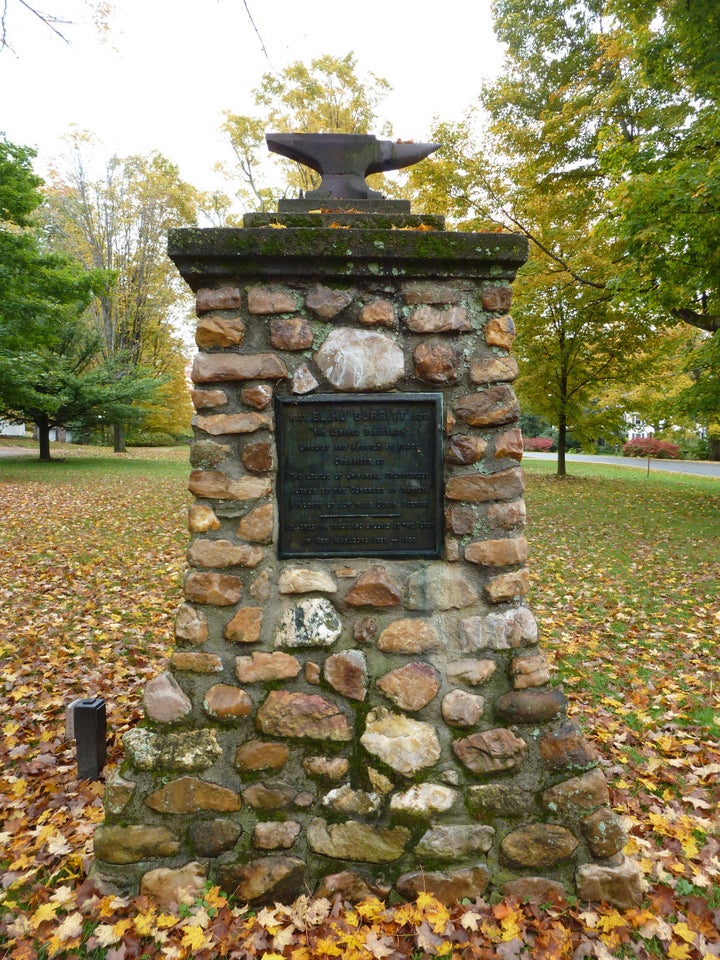
Monument to Elihu Burritt, the learned blacksmith, in New Marlboro, Mass
Historical statues and monuments are in the news, but sadly not because Americans have taken a new interest in understanding their history. Statues of men who supported the Confederacy, prominent generals like Robert E. Lee and Stonewall Jackson, for example, have been appropriated by White supremacists (this is nothing new, actually). Such statues have been defended as “beautiful” by a man, Donald Trump, with little sense of history, even as other Americans have called for these and similar statues to be removed.
Statues, of course, are just that. Inanimate objects. Places for pigeons to poop. It’s we who invest them with meaning. Most people, I think, take little notice of statues and monuments until they become controversial, after which everyone has an opinion.
For me, statues and monuments are a stimulus for reflection as well as education. Who was that guy on a horse? Why is he being honored? And what does that decision tell us about who we were and are as a people?
As a people, we choose certain historical figures as worthy of being sculpted in stone or cast in bronze. We choose our heroes, so to speak, our paragons, our worthies. And our choices are just that ― choices. They reflect certain values, priorities, motives, feelings. And since our values, our motives, our sense of what is good and bad, right and wrong, change over time, so too can our statues and memorials change, if that is the will of the people in a democracy that enshrines freedom of choice.
If the peoples of various states choose to remove certain statues, so be it. Other statues might take their place; other worthies might be selected as more in keeping with the times and our values as we conceive them today as a people.
What we choose to memorialize as a people says much about ourselves. Many statues and memorials fall under the category of “man on horseback.” Certainly, military figures like Lee and Jackson were considered great men of their times, at least in a Confederate context. They also, sadly, became potent symbols of racism in the Jim Crow South, physical symbols of the myth of the Lost Cause, intimidating and demoralizing figures to Black communities struggling against violence and prejudice.
Americans are an intemperate lot, driven by extremes, constantly fighting to reconfigure ourselves through our interpretation and re-interpretation of history. All this is proof to William Faulkner’s famous saying that, “The past is not dead. It’s not even past.”
As a historian, I find it deeply sad as well as ironic that, at a time when education in history is withering in the United States, the importance of history has arguably never been greater. We should use statues as a stimulus for learning, but instead they’re more often appropriated as a driver for divisiveness.
If nothing else, today’s debates about statues should remind us yet again of the importance of history and a proper understanding of it. History is inherently disputatious. Controversial. Challenging. Exciting. If we can tap the heat generated by the latest controversies and warm students to a study of history in all its richness, perhaps some good can come from the ongoing controversy.
What kind of statues and memorials are the “right” ones for America? It’s a vexing question, is it not? It’s also a question with powerful implications. I come back to George Orwell’s comment (slightly paraphrased): He who controls the past controls the future. He who controls the present controls the past.
Our understanding of the past ― our selective celebration of it ― helps to define what is possible in the future. If you celebrate generals on horseback ― military men of the Confederacy ― you make a choice that helps to shape what is seen as right and proper in the present moment, and what will be right and proper in the future.
For a better future, I’d like to see fewer statues to military men and sports heroes and the like, and more to visionaries who sought a better way for us as a people. I recall a small monument I saw to Elihu Burritt in Massachusetts. No one is talking about him or his legacy today. He’s an obscure figure compared to his contemporaries, Lee and Jackson. Known as the “Learned Blacksmith,” he was a committed pacifist and abolitionist who worked to educate the less fortunate in society.
If we are to build prominent statues and monuments, would it not be better to build them to people like Elihu Burritt, people who worked for justice and equality, people who fought against war and slavery and for peace and freedom?
Astore, a retired lieutenant colonel (USAF) and historian, blogs at Bracing Views.
